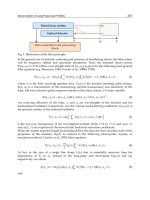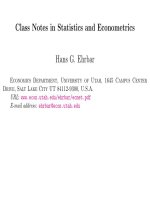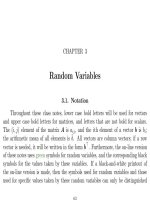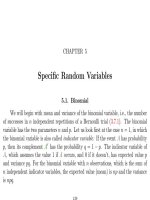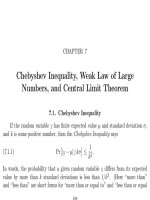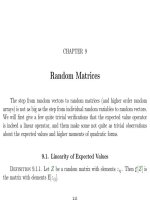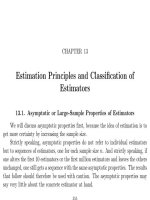Class Notes in Statistics and Econometrics Part 14 ppsx
Bạn đang xem bản rút gọn của tài liệu. Xem và tải ngay bản đầy đủ của tài liệu tại đây (419.24 KB, 34 trang )
CHAPTER 27
Best Linear Prediction
Best Linear Prediction is the second basic building block for the linear model,
in addition to the OLS model. Instead of estimating a nonrandom parameter β
about which no prior information is available, in the present situation one predicts
a random variable z whose mean and covariance matrix are known. Most models to
be discussed below are somewhere between these two extremes.
Christensen’s [Chr87] is one of the few textbooks which treat best linear predic-
tion on the basis of known first and second moments in parallel with the regression
model. The two models have indeed so much in common that they should be treated
together.
703
704 27. BEST LINEAR PREDICTION
27.1. Minimum Mean Squared Error, Unbiasedness Not Required
Assume the expected values of the random vectors y and z are known, and their
joint covariance matrix is known up to an unknown scalar factor σ
2
> 0. We will
write this as
(27.1.1)
y
z
∼
µ
ν
, σ
2
Ω
Ω
Ω
yy
Ω
Ω
Ω
yz
Ω
Ω
Ω
zy
Ω
Ω
Ω
zz
, σ
2
> 0.
y is observed but z is not, and the goal is to predict z on the basis of the observation
of y.
There is a unique predictor of the form z
∗
= B
∗
y+b
∗
(i.e., it is linear with a con-
stant term, the technical term for this is “affine”) with the following two properties:
it is unbiased, and the prediction error is uncorrelated with y, i.e.,
(27.1.2)
C
[z
∗
− z, y] = O.
The formulas for B
∗
and b
∗
are easily derived. Unbiasedness means ν = B
∗
µ + b
∗
,
the predictor has therefore the form
(27.1.3) z
∗
= ν + B
∗
(y −µ).
Since
(27.1.4) z
∗
− z = B
∗
(y −µ) −(z −ν) =
B
∗
−I
y −µ
z −ν
,
27.1. MINIMUM MEAN SQUARED ERROR, UNBIASEDNESS NOT REQUIRED 705
the zero correlation condition (27.1.2) translates into
(27.1.5) B
∗
Ω
Ω
Ω
yy
= Ω
Ω
Ω
zy
,
which, due to equation (A.5.13) holds for B
∗
= Ω
Ω
Ω
zy
Ω
Ω
Ω
−
yy
. Therefore the predictor
(27.1.6) z
∗
= ν + Ω
Ω
Ω
zy
Ω
Ω
Ω
−
yy
(y −µ)
satisfies the two requirements.
Unbiasedness and condition (27.1.2) are sometimes interpreted to mean that z
∗
is an optimal predictor. Unbiasedness is often naively (but erroneously) considered
to be a necessary condition for good estimators. And if the prediction error were
correlated with the observed variable, the argument goes, then it would be possible to
improve the prediction. Theorem 27.1.1 shows that despite the flaws in the argument,
the result which it purports to show is indeed valid: z
∗
has the minimum MSE of
all affine predictors, whether biased or not, of z on the basis of y.
Theorem 27.1.1. In situation (27.1.1), the predictor (27.1.6) has, among all
predictors of z which are affine functions of y, the smallest MSE matrix. Its MSE
matrix is
(27.1.7) MSE[z
∗
; z] =
E
[(z
∗
− z)(z
∗
− z)
] = σ
2
(Ω
Ω
Ω
zz
−Ω
Ω
Ω
zy
Ω
Ω
Ω
−
yy
Ω
Ω
Ω
yz
) = σ
2
Ω
Ω
Ω
zz.y
.
706 27. BEST LINEAR PREDICTION
Proof. Look at any predictor of the form
˜
z =
˜
By +
˜
b. Its bias is
˜
d =
E
[
˜
z −z] =
˜
Bµ +
˜
b − ν, and by (23.1.2) one can write
E
[(
˜
z −z)(
˜
z −z)
] =
V
[(
˜
z −z)] +
˜
d
˜
d
(27.1.8)
=
V
˜
B −I
y
z
+
˜
d
˜
d
(27.1.9)
= σ
2
˜
B −I
Ω
Ω
Ω
yy
Ω
Ω
Ω
yz
Ω
Ω
Ω
zy
Ω
Ω
Ω
zz
˜
B
−I
+
˜
d
˜
d
.(27.1.10)
This MSE-matrix is minimized if and only if d
∗
= o and B
∗
satisfies (27.1.5). To see
this, take any solution B
∗
of (27.1.5), and write
˜
B = B
∗
+
˜
D. Since, due to theorem
A.5.11, Ω
Ω
Ω
zy
= Ω
Ω
Ω
zy
Ω
Ω
Ω
−
yy
Ω
Ω
Ω
yy
, it follows Ω
Ω
Ω
zy
B
∗
= Ω
Ω
Ω
zy
Ω
Ω
Ω
−
yy
Ω
Ω
Ω
yy
B
∗
= Ω
Ω
Ω
zy
Ω
Ω
Ω
−
yy
Ω
Ω
Ω
yz
.
27.1. MINIMUM MEAN SQUARED ERROR, UNBIASEDNESS NOT REQUIRED 707
Therefore
MSE[
˜
z; z] = σ
2
B
∗
+
˜
D −I
Ω
Ω
Ω
yy
Ω
Ω
Ω
yz
Ω
Ω
Ω
zy
Ω
Ω
Ω
zz
B
∗
+
˜
D
−I
+
˜
d
˜
d
= σ
2
B
∗
+
˜
D −I
Ω
Ω
Ω
yy
˜
D
−Ω
Ω
Ω
zz.y
+ Ω
Ω
Ω
zy
˜
D
+
˜
d
˜
d
(27.1.11)
= σ
2
(Ω
Ω
Ω
zz.y
+
˜
DΩ
Ω
Ω
yy
˜
D
) +
˜
d
˜
d
.(27.1.12)
The MSE matrix is therefore minimized (with minimum value σ
2
Ω
Ω
Ω
zz.y
) if and only
if
˜
d = o and
˜
DΩ
Ω
Ω
yy
= O which means that
˜
B, along with B
∗
, satisfies (27.1.5).
Problem 324. Show that the solution of this minimum MSE problem is unique
in the following sense: if B
∗
1
and B
∗
2
are two different solutions of (27.1.5) and y
is any feasible observed value y, plugged into equations (27.1.3) they will lead to the
same p redicted value z
∗
.
Answer. Comes from the fact that every feasible observed value of y can be written in the
form y = µ + Ω
Ω
Ω
yy
q for some q, therefore B
∗
i
y = B
∗
i
Ω
Ω
Ω
yy
q = Ω
Ω
Ω
zy
q.
708 27. BEST LINEAR PREDICTION
The matrix B
∗
is also called the regression matrix of z on y, and the unscaled
covariance matrix has the form
(27.1.13) Ω
Ω
Ω =
Ω
Ω
Ω
yy
Ω
Ω
Ω
yz
Ω
Ω
Ω
zy
Ω
Ω
Ω
zz
=
Ω
Ω
Ω
yy
Ω
Ω
Ω
yy
X
XΩ
Ω
Ω
yy
XΩ
Ω
Ω
yy
X
+ Ω
Ω
Ω
zz.y
Where we wrote here B
∗
= X in order to make the analogy with regression clearer.
A g-inverse is
(27.1.14) Ω
Ω
Ω
−
=
Ω
Ω
Ω
−
yy
+ X
Ω
Ω
Ω
−
zz.y
X −X
Ω
Ω
Ω
−
zz.y
−X
Ω
Ω
Ω
−
zz.y
Ω
Ω
Ω
−
zz.y
and every g-inverse of the covariance matrix has a g-inverse of Ω
Ω
Ω
zz.y
as its zz-
partition. (Proof in Problem 592.)
If Ω
Ω
Ω =
Ω
Ω
Ω
yy
Ω
Ω
Ω
yz
Ω
Ω
Ω
zy
Ω
Ω
Ω
zz
is nonsingular, 27.1.5 is also solved by B
∗
= −(Ω
Ω
Ω
zz
)
−
Ω
Ω
Ω
zy
where Ω
Ω
Ω
zz
and Ω
Ω
Ω
zy
are the corresponding partitions of the inverse Ω
Ω
Ω
−1
. See Problem
592 for a proof. Therefore instead of 27.1.6 the predictor can also be written
(27.1.15) z
∗
= ν −
Ω
Ω
Ω
zz
−1
Ω
Ω
Ω
zy
(y −µ)
(note the minus sign) or
(27.1.16) z
∗
= ν −Ω
Ω
Ω
zz.y
Ω
Ω
Ω
zy
(y −µ).
27.1. MINIMUM MEAN SQUARED ERROR, UNBIASEDNESS NOT REQUIRED 709
Problem 325. This problem utilizes the concept of a bounded risk estimator,
which is not yet explained very well in these notes. Assume y, z, µ, and ν are
jointly distributed random vectors. First assume ν and µ are observed, but y and z
are not. Assume we know that in this case, the best linear bounded MSE predictor
of y and z is µ and ν, with prediction errors distributed as follows:
(27.1.17)
y −µ
z −ν
∼
o
o
, σ
2
Ω
Ω
Ω
yy
Ω
Ω
Ω
yz
Ω
Ω
Ω
zy
Ω
Ω
Ω
zz
.
This is the initial information. Here it is unnecessary to specify the unconditional
distributions of µ and ν, i.e.,
E
[µ] and
E
[ν] as well as the joint covariance matrix
of µ and ν are not needed, even if they are known.
Then in a second step assume that an observation of y becomes available, i.e.,
now y, ν, and µ are observed, but z still isn’t. Then the predictor
(27.1.18) z
∗
= ν + Ω
Ω
Ω
zy
Ω
Ω
Ω
−
yy
(y −µ)
is th e best linear bounded MSE predictor of z based on y, µ, and ν.
• a. Give special cases of this specification in which µ and ν are constant and y
and z random, and one in which µ and ν and y are random and z is constant, and
one in which µ and ν are random and y and z are constant.
710 27. BEST LINEAR PREDICTION
Answer. If µ and ν are constant, they are written µ and ν. From this follows µ =
E
[y] and
ν =
E
[z] and σ
2
Ω
Ω
Ω
yy
Ω
Ω
Ω
yz
Ω
Ω
Ω
zy
Ω
Ω
Ω
zz
=
V
[
y
rx
] and every linear predictor has bounded MSE. Then the
proof is as given earlier in this chapter. But an example in which µ and ν are not known constants
but are observed random variables, and y is also a random variable but z is constant, is (28.0.26).
Another example, in which y and z both are constants and µ and ν random, is constrained least
squares (29.4.3).
• b. Prove equation 27.1.18.
Answer. In this proof we allow all four µ and ν and y and z to be random. A linear
predictor based on y, µ, and ν can be written as
˜
z = By + Cµ + Dν + d, therefore
˜
z − z =
B(y −µ) + (C + B)µ + (D −I)ν −(z −ν) + d.
E
[
˜
z −z] = o + (C + B)
E
[µ] + (D −I)
E
[ν] −o + d.
Assuming that
E
[µ] and
E
[ν] can be anything, the requirement of bounded MSE (or simply the
requirement of unbiasedness, bu t this is not as elegant) gives C = −B and D = I, therefore
˜
z = ν + B(y − µ) + d, and the estimation error is
˜
z − z = B(y − µ) − (z − ν) + d. Now continue
as in the proof of theorem 27.1.1. I must still carry out this proof much more carefully!
Problem 326. 4 points According to (27.1.2), the prediction error z
∗
− z is
uncorrelated with y. If the distribution is such that the prediction error is even
independent of y (as is the case if y and z are jointly normal), then z
∗
as defined
in (27.1.6) is the conditional mean z
∗
=
E
[z|y], and its MSE-matrix as defined in
(27.1.7) is the conditional variance
V
[z|y].
27.1. MINIMUM MEAN SQUARED ERROR, UNBIASEDNESS NOT REQUIRED 711
Answer. From independence follows
E
[z
∗
− z|y] =
E
[z
∗
− z], and by the law of iterated
expectation s
E
[z
∗
− z] = o. Rewrite this as
E
[z|y] =
E
[z
∗
|y]. But since z
∗
is a function of y,
E
[z
∗
|y] = z
∗
. Now the proof that the conditional dispersion matrix is the MSE matrix:
V
[z|y] =
E
[(z −
E
[z|y])(z −
E
[z|y])
|y] =
E
[(z − z
∗
)(z − z
∗
)
|y]
=
E
[(z − z
∗
)(z − z
∗
)
] = MSE[z
∗
; z].
(27.1.19)
Problem 327. Assume the expected values of x, y and z are known, and their
joint covariance matrix is known up to an unknown scalar factor σ
2
> 0.
(27.1.20)
x
y
z
∼
λ
µ
ν
, σ
2
Ω
Ω
Ω
xx
Ω
Ω
Ω
xy
Ω
Ω
Ω
xz
Ω
Ω
Ω
xy
Ω
Ω
Ω
yy
Ω
Ω
Ω
yz
Ω
Ω
Ω
xz
Ω
Ω
Ω
yz
Ω
Ω
Ω
zz
.
x is the original information, y is additional information which becomes available,
and z is the variable which we want to predict on the basis of this information.
• a. 2 points Show that y
∗
= µ + Ω
Ω
Ω
xy
Ω
Ω
Ω
−
xx
(x − λ) is the best linear predictor
of y and z
∗
= ν + Ω
Ω
Ω
xz
Ω
Ω
Ω
−
xx
(x − λ) the best linear predictor of z on the basis of the
712 27. BEST LINEAR PREDICTION
observation of x, and that their joint MSE-matrix is
E
y
∗
− y
z
∗
− z
(y
∗
− y)
(z
∗
− z)
= σ
2
Ω
Ω
Ω
yy
−Ω
Ω
Ω
xy
Ω
Ω
Ω
−
xx
Ω
Ω
Ω
xy
Ω
Ω
Ω
yz
−Ω
Ω
Ω
xy
Ω
Ω
Ω
−
xx
Ω
Ω
Ω
xz
Ω
Ω
Ω
yz
−Ω
Ω
Ω
xz
Ω
Ω
Ω
−
xx
Ω
Ω
Ω
xy
Ω
Ω
Ω
zz
−Ω
Ω
Ω
xz
Ω
Ω
Ω
−
xx
Ω
Ω
Ω
xz
which can also be written
= σ
2
Ω
Ω
Ω
yy.x
Ω
Ω
Ω
yz.x
Ω
Ω
Ω
yz.x
Ω
Ω
Ω
zz.x
.
Answer. This part of the question is a simple application of the formulas derived earlier. For
the MSE-matrix you first get
σ
2
Ω
Ω
Ω
yy
Ω
Ω
Ω
yz
Ω
Ω
Ω
yz
Ω
Ω
Ω
zz
−
Ω
Ω
Ω
xy
Ω
Ω
Ω
xz
Ω
Ω
Ω
−
xx
Ω
Ω
Ω
xy
Ω
Ω
Ω
xz
• b. 5 points Show that the best linear predictor of z on the basis of the obser-
vations of x and y has the form
(27.1.21) z
∗∗
= z
∗
+ Ω
Ω
Ω
yz.x
Ω
Ω
Ω
−
yy.x
(y −y
∗
)
This is an important formula. All you need to compute z
∗∗
is the best estimate
z
∗
before the new information y became available, the best estimate y
∗
of that new
27.1. MINIMUM MEAN SQUARED ERROR, UNBIASEDNESS NOT REQUIRED 713
information itself, and the joint MSE matrix of the two. The original data x and
the covariance matrix (27.1.20) do not enter this formula.
Answer. Follows from
z
∗∗
= ν +
Ω
Ω
Ω
xz
Ω
Ω
Ω
yz
Ω
Ω
Ω
xx
Ω
Ω
Ω
xy
Ω
Ω
Ω
xy
Ω
Ω
Ω
yy
−
x − λ
y − µ
=
Now apply (A.8.2):
= ν +
Ω
Ω
Ω
xz
Ω
Ω
Ω
yz
Ω
Ω
Ω
−
xx
+ Ω
Ω
Ω
−
xx
Ω
Ω
Ω
xy
Ω
Ω
Ω
−
yy.x
Ω
Ω
Ω
xy
Ω
Ω
Ω
−
xx
−Ω
Ω
Ω
−
xx
Ω
Ω
Ω
xy
Ω
Ω
Ω
−
yy.x
−Ω
Ω
Ω
−
yy.x
Ω
Ω
Ω
xy
Ω
Ω
Ω
−
xx
Ω
Ω
Ω
−
yy.x
x − λ
y − µ
=
= ν +
Ω
Ω
Ω
xz
Ω
Ω
Ω
yz
Ω
Ω
Ω
−
xx
(x − λ) + Ω
Ω
Ω
−
xx
Ω
Ω
Ω
xy
Ω
Ω
Ω
−
yy.x
(y
∗
− µ) −Ω
Ω
Ω
−
xx
Ω
Ω
Ω
xy
Ω
Ω
Ω
−
yy.x
(y − µ)
−Ω
Ω
Ω
−
yy.x
(y
∗
− µ) + Ω
Ω
Ω
−
yy.x
(y − µ)
=
= ν +
Ω
Ω
Ω
xz
Ω
Ω
Ω
yz
Ω
Ω
Ω
−
xx
(x − λ) −Ω
Ω
Ω
−
xx
Ω
Ω
Ω
xy
Ω
Ω
Ω
−
yy.x
(y − y
∗
)
+Ω
Ω
Ω
−
yy.x
(y − y
∗
)
=
= ν + Ω
Ω
Ω
xz
Ω
Ω
Ω
−
xx
(x − λ) −Ω
Ω
Ω
xz
Ω
Ω
Ω
−
xx
Ω
Ω
Ω
xy
Ω
Ω
Ω
−
yy.x
(y − y
∗
) + Ω
Ω
Ω
yz
Ω
Ω
Ω
−
yy.x
(y − y
∗
) =
= z
∗
+
Ω
Ω
Ω
yz
−Ω
Ω
Ω
xz
Ω
Ω
Ω
−
xx
Ω
Ω
Ω
xy
Ω
Ω
Ω
−
yy.x
(y − y
∗
) = z
∗
+ Ω
Ω
Ω
yz.x
Ω
Ω
Ω
−
yy.x
(y − y
∗
)
Problem 328. Assume x, y, and z have a joint probability distribution, and
the conditional expectation
E
[z|x, y] = α
∗
+ A
∗
x + B
∗
y is linear in x and y.
714 27. BEST LINEAR PREDICTION
• a. 1 point Show that
E
[z|x] = α
∗
+ A
∗
x + B
∗
E
[y|x]. Hint: you may use the
law of iterated expectations in the following form:
E
[z|x] =
E
E
[z|x, y]
x
.
Answer. With this hint it is trivial:
E
[z|x] =
E
α
∗
+ A
∗
x + B
∗
y
x
= α
∗
+ A
∗
x + B
∗
E
[y|x].
• b. 1 point The next three examples are from [CW99, pp. 264/5]: Assume
E[z|x, y] = 1 + 2x + 3y, x and y are independent, and E[y] = 2. Compute E[z|x].
Answer. According to the formula, E[z|x] = 1 + 2x + 3E[y|x], but since x and y are indepen-
dent, E[y|x] = E[y] = 2; therefore E[z|x] = 7 + 2x. I.e., the slope is the same, but the intercept
changes.
• c. 1 point Assume again E[z|x, y] = 1 + 2x + 3y, but this time x and y are not
independent but E[y|x] = 2 − x. Compute E[z|x].
Answer. E[z|x] = 1+2x+3(2−x) = 7−x. In this situation, both slope and intercept change,
but it is still a linear relationship.
• d. 1 point Again E[z|x, y] = 1 + 2x + 3y, and this time the relationship between
x and y is nonlinear: E[y|x] = 2 − e
x
. Compute E[z|x].
Answer. E[z|x] = 1 + 2x + 3(2 − e
x
) = 7 + 2x − 3e
x
. This time the marginal relationship
between x and y is no longer linear. This is so despite the fact that, if all the variables are included,
i.e., if both x and y are included, then the relationship is linear.
27.1. MINIMUM MEAN SQUARED ERROR, UNBIASEDNESS NOT REQUIRED 715
• e. 1 point Assume E[f(z)|x, y] = 1 + 2x + 3y, where f is a nonlinear function,
and E[y|x] = 2 − x. Compute E[f(z)|x].
Answer. E[f(z)|x] = 1 + 2x + 3(2 −x) = 7 −x. If one plots z against x and z, then the plots
should be similar, though not identical, since the same transformation f will straighten them out.
This is why the plots in the top row or right column of [CW99, p. 435 ] are so similar.
Connection between prediction and inverse prediction: If y is observed and z
is to be predicted, the BLUP is z
∗
− ν = B
∗
(y − µ) where B
∗
= Ω
Ω
Ω
zy
Ω
Ω
Ω
−
yy
. If z
is observed and y is to be predicted, then the BLUP is y
∗
− µ = C
∗
(z − ν) with
C
∗
= Ω
Ω
Ω
yz
Ω
Ω
Ω
−
zz
. B
∗
and C
∗
are connected by the formula
(27.1.22) Ω
Ω
Ω
yy
B
∗
= C
∗
Ω
Ω
Ω
zz
.
This relationship can be used for graphical regression methods [Coo98, pp. 187/8]:
If z is a scalar, it is much easier to determine the elements of C
∗
than those of
B
∗
. C
∗
consists of the regression slopes in the scatter plot of each of the observed
variables against z. They can be read off easily from a scatterplot matrix. This
works not only if the distribution is Normal, but also with arbitrary distributions as
long as all conditional expectations between the explanatory variables are linear.
Problem 329. In order to make relationship (27.1.22) more intuitive, assume x
and ε are Normally distributed and independent of each other, and E[ε] = 0. Define
y = α + βx + ε.
716 27. BEST LINEAR PREDICTION
• a. Show that α + βx is the best linear predictor of y based on the observation
of x.
Answer. Follows from the fact that the predictor is unbiased and the prediction error is
uncorrelated with x.
• b. Express β in terms of the variances and covariances of x and y.
Answer. cov[x, y] = β var[x], therefore β =
cov[
x,y]
var[x]
• c. Since x and y are jointly normal, they can also be written x = γ + δy + ω
where ω is independent of y. Express δ in terms of the variances and covariances of
x and y, and show that var[y]β = γ var[x].
Answer. δ =
cov[x,y]
var[y]
.
• d. Now let us extend the model a little: assume x
1
, x
2
, and ε are Normally
distributed and independent of each other, and E[ε] = 0. Define y = α + β
1
x
1
+
β
2
x
2
+ ε. Again express β
1
and β
2
in terms of variances and covariances of x
1
, x
2
,
and y.
Answer. Since x
1
and x
2
are indep end ent, one gets the same formulas as in the univariate
case: from cov[x
1
, y] = β
1
var[x
1
] and cov[x
2
, y] = β
2
var[x
2
] follows β
1
=
cov[x
1
,y]
var[x
1
]
and β
2
=
cov[x
2
,y]
var[x
2
]
.
27.2. T HE ASSOCIATED LEAST SQUARES PROBLEM 717
• e. Since x
1
and y are jointly normal, they can also be written x
1
= γ
1
+δ
1
y+ω
1
,
where ω
1
is independent of y. Likewise, x
2
= γ
2
+ δ
2
y + ω
2
, where ω
2
is independent
of y. Express δ
1
and δ
2
in terms of the variances and covariances of x
1
, x
2
, and y,
and show that
(27.1.23)
δ
1
δ
2
var[y] =
var[x
1
] 0
0 var[x
2
]
β
1
β
2
This is (27.1.22) in the present situation.
Answer. δ
1
=
cov[x
1
,y]
var[y]
and δ
2
=
cov[x
2
,y]
var[y]
.
27.2. The Associated Least Squares Problem
For every estimation problem there is an associated “least squares” problem. In
the present situation, z
∗
is that value which, together with the given observation y,
“blends best” into the population defined by µ, ν and the dispersion matrix Ω
Ω
Ω, in
the following sense: Given the observed value y, the vector z
∗
= ν +Ω
Ω
Ω
zy
Ω
Ω
Ω
−
yy
(y −µ)
is that value z for which
y
z
has smallest Mahalanobis distance from the population
defined by the mean vector
µ
ν
and the covariance matrix σ
2
Ω
Ω
Ω
yy
Ω
Ω
Ω
yz
Ω
Ω
Ω
zy
Ω
Ω
Ω
zz
.
718 27. BEST LINEAR PREDICTION
In the case of singular Ω
Ω
Ω
zz
, it is only necessary to minimize among those z
which have finite distance from the population, i.e., which can be written in the form
z = ν + Ω
Ω
Ω
zz
q for some q. We will also write r = rank
Ω
Ω
Ω
yy
Ω
Ω
Ω
yz
Ω
Ω
Ω
zy
Ω
Ω
Ω
zz
. Therefore, z
∗
solves the following “least squares problem:”
(27.2.1)
z = z
∗
min.
1
rσ
2
y −µ
z −ν
Ω
Ω
Ω
yy
Ω
Ω
Ω
yz
Ω
Ω
Ω
zy
Ω
Ω
Ω
zz
−
y −µ
z −ν
s. t. z = ν + Ω
Ω
Ω
zz
q for some q.
To prove this, use (A.8.2) to invert the dispersion matrix:
(27.2.2)
Ω
Ω
Ω
yy
Ω
Ω
Ω
yz
Ω
Ω
Ω
zy
Ω
Ω
Ω
zz
−
=
Ω
Ω
Ω
−
yy
+ Ω
Ω
Ω
−
yy
Ω
Ω
Ω
yz
Ω
Ω
Ω
−
zz.y
Ω
Ω
Ω
zy
Ω
Ω
Ω
−
yy
−Ω
Ω
Ω
−
yy
Ω
Ω
Ω
yz
Ω
Ω
Ω
−
zz.y
−Ω
Ω
Ω
−
zz.y
Ω
Ω
Ω
zy
Ω
Ω
Ω
−
yy
Ω
Ω
Ω
−
zz.y
.
If one plugs z = z
∗
into this objective function, one obtains a very simple expression:
(27.2.3)
(y−µ)
I Ω
Ω
Ω
−
yy
Ω
Ω
Ω
yz
Ω
Ω
Ω
−
yy
+ Ω
Ω
Ω
−
yy
Ω
Ω
Ω
yz
Ω
Ω
Ω
−
zz.y
Ω
Ω
Ω
zy
Ω
Ω
Ω
−
yy
−Ω
Ω
Ω
−
yy
Ω
Ω
Ω
yz
Ω
Ω
Ω
−
zz.y
−Ω
Ω
Ω
−
zz.y
Ω
Ω
Ω
zy
Ω
Ω
Ω
−
yy
Ω
Ω
Ω
−
zz.y
I
Ω
Ω
Ω
zy
Ω
Ω
Ω
−
yy
(y−µ) =
(27.2.4) = (y −µ)
Ω
Ω
Ω
−
yy
(y −µ).
27.2. T HE ASSOCIATED LEAST SQUARES PROBLEM 719
Now take any z of the form z = ν + Ω
Ω
Ω
zz
q for some q and write it in the form
z = z
∗
+ Ω
Ω
Ω
zz
d, i.e.,
y −µ
z −ν
=
y −µ
z
∗
− ν
+
o
Ω
Ω
Ω
zz
d
.
Then the cross product terms in the objective function disappear:
(27.2.5)
o
d
Ω
Ω
Ω
zz
Ω
Ω
Ω
−
yy
+ Ω
Ω
Ω
−
yy
Ω
Ω
Ω
yz
Ω
Ω
Ω
−
zz.y
Ω
Ω
Ω
zy
Ω
Ω
Ω
−
yy
−Ω
Ω
Ω
−
yy
Ω
Ω
Ω
yz
Ω
Ω
Ω
−
zz.y
−Ω
Ω
Ω
−
zz.y
Ω
Ω
Ω
zy
Ω
Ω
Ω
−
yy
Ω
Ω
Ω
−
zz.y
I
Ω
Ω
Ω
zy
Ω
Ω
Ω
−
yy
(y−µ) =
=
o
d
Ω
Ω
Ω
zz
Ω
Ω
Ω
−
yy
O
(y −µ) = 0
Therefore this gives a larger value of the objective function.
Problem 330. Use problem 579 for an alternative proof of this.
From (27.2.1) follows that z
∗
is the mode of the normal density function, and
since the mode is the mean, this is an alternative proof, in the case of nonsingular
covariance matrix, when the density exists, that z
∗
is the normal conditional mean.
720 27. BEST LINEAR PREDICTION
27.3. Prediction of Future Observations in the Regression Model
For a moment let us go back to the model y = Xβ+ε
ε
ε with spherically distributed
disturbances ε
ε
ε ∼ (o, σ
2
I). This time, our goal is not to estimate β, but the situation
is the following: For a new set of observations of the explanatory variables X
0
the
values of the dependent variable y
0
= X
0
β + ε
ε
ε
0
have not yet been observed and we
want to predict them. The obvious predictor is y
∗
0
= X
0
ˆ
β = X
0
(X
X)
−1
X
y.
Since
(27.3.1) y
∗
0
− y
0
= X
0
(X
X)
−1
X
y −y
0
=
= X
0
(X
X)
−1
X
Xβ+X
0
(X
X)
−1
X
ε
ε
ε−X
0
β−ε
ε
ε
0
= X
0
(X
X)
−1
X
ε
ε
ε−ε
ε
ε
0
one sees that E[y
∗
0
− y
0
] = o, i.e., it is an unbiased predictor. And since ε
ε
ε and ε
ε
ε
0
are uncorrelated, one obtains
MSE[y
∗
0
; y
0
] =
V
[y
∗
0
− y
0
] =
V
[X
0
(X
X)
−1
X
ε
ε
ε] +
V
[ε
ε
ε
0
](27.3.2)
= σ
2
(X
0
(X
X)
−1
X
0
+ I).(27.3.3)
Problem 331 shows that this is the Best Linear Unbiased Predictor (BLUP) of y
0
on
the basis of y.
27.3. PREDICT ION OF FUTURE OBSERVATIONS IN THE REGRESSION MODEL 721
Problem 331. The prediction problem in the Ordinary Least Squares model can
be formulated as follows:
(27.3.4)
y
y
0
=
X
X
0
β +
ε
ε
ε
ε
ε
ε
0
E
[
ε
ε
ε
ε
ε
ε
0
] =
o
o
V
[
ε
ε
ε
ε
ε
ε
0
] = σ
2
I O
O I
.
X and X
0
are known, y is observed, y
0
is no t observed.
• a. 4 points Show that y
∗
0
= X
0
ˆ
β is the Best Linear Unbiased Predictor (BLUP)
of y
0
on the basis of y, where
ˆ
β is the OLS estimate in the model y = Xβ + ε
ε
ε.
Answer. Take any other predictor
˜
y
0
=
˜
By and write
˜
B = X
0
(X
X)
−1
X
+D. Unbiased-
ness means
E
[
˜
y
0
− y
0
] = X
0
(X
X)
−1
X
Xβ + DXβ − X
0
β = o, from which follows DX = O.
Because of unbiasedness we know MSE[
˜
y
0
; y
0
] =
V
[
˜
y
0
− y
0
]. Since the prediction error can be
written
˜
y
0
− y =
X
0
(X
X)
−1
X
+ D −I
y
y
0
, one obtains
V
[
˜
y
0
− y
0
] =
X
0
(X
X)
−1
X
+ D −I
V
[
y
y
0
]
X(X
X)
−1
X
0
+ D
−I
= σ
2
X
0
(X
X)
−1
X
+ D −I
X(X
X)
−1
X
0
+ D
−I
= σ
2
X
0
(X
X)
−1
X
+ D
X
0
(X
X)
−1
X
+ D
+ σ
2
I
= σ
2
X
0
(X
X)
−1
X
0
+ DD
+ I
.
722 27. BEST LINEAR PREDICTION
This is smallest for D = O.
• b. 2 points From our formulation of the Gauss-Markov theorem in Theorem
24.1.1 it is obvious that the same y
∗
0
= X
0
ˆ
β is also the Best Linear Unbiased Es-
timator of X
0
β, which is the expected value of y
0
. You are not required to re-
prove this here, but you are asked to compute MSE[X
0
ˆ
β; X
0
β] and compare it with
MSE[y
∗
0
; y
0
]. Can you explain the difference?
Answer. Estimation error and MSE are
X
0
ˆ
β − X
0
β = X
0
(
ˆ
β − β) = X
0
(X
X)
−1
X
ε
ε
ε due to (??)
MSE[X
0
ˆ
β; X
0
β] =
V
[X
0
ˆ
β − X
0
β] =
V
[X
0
(X
X)
−1
X
ε
ε
ε] = σ
2
X
0
(X
X)
−1
X
0
.
It differs from the prediction MSE matrix by σ
2
I, which is the uncertainty about the value of the
new disturbance ε
ε
ε
0
about which the data have no information.
[Gre97, p. 369] has an enlightening formula showing how the prediction intervals
increase if one goes away from the center of the data.
Now let us look at the prediction problem in the Generalized Least Squares
model
(27.3.5)
y
y
0
=
X
X
0
β +
ε
ε
ε
ε
ε
ε
0
E
ε
ε
ε
ε
ε
ε
0
=
o
o
V
ε
ε
ε
ε
ε
ε
0
= σ
2
Ψ C
C
Ψ
0
.
27.3. PREDICT ION OF FUTURE OBSERVATIONS IN THE REGRESSION MODEL 723
X and X
0
are known, y is observed, y
0
is not observed, and we assume Ψ is positive
definite. If C = O, the BLUP of y
0
is X
0
ˆ
β, where
ˆ
β is the BLUE in the model
y = Xβ + ε
ε
ε. In other words, all new disturbances are simply predicted by zero. If
past and future disturbances are correlated, this predictor is no longer optimal.
In [JHG
+
88, pp. 343–346] it is proved that the best linear unbiased predictor
of y
0
is
(27.3.6) y
∗
0
= X
0
ˆ
β + C
Ψ
−1
(y −X
ˆ
β).
where
ˆ
β is the generalized least squares estimator of β, and that its MSE-matrix
MSE[y
∗
0
; y
0
] is
(27.3.7) σ
2
Ψ
0
−C
Ψ
−1
C +(X
0
−C
Ψ
−1
X)(X
Ψ
−1
X)
−1
(X
0
−X
Ψ
−1
C)
.
Problem 332. Derive the formula for the MSE matrix from the formula of
the predictor, and compute the joint MSE matrix for the predicted values and the
parameter vector.
724 27. BEST LINEAR PREDICTION
Answer. The prediction error is, using (26.0.3),
y
∗
0
− y
0
= X
0
ˆ
β − X
0
β + X
0
β − y
0
+ C
Ψ
−1
(y − Xβ + Xβ − X
ˆ
β)(27.3.8)
= X
0
(
ˆ
β − β) −ε
ε
ε
0
+ C
Ψ
−1
(ε
ε
ε − X(
ˆ
β − β))(27.3.9)
= C
Ψ
−1
ε
ε
ε + (X
0
− C
Ψ
−1
X)(
ˆ
β − β) −ε
ε
ε
0
(27.3.10)
=
C
Ψ
−1
+ (X
0
− C
Ψ
−1
X)(X
Ψ
−1
X)
−1
X
Ψ
−1
−I
ε
ε
ε
ε
ε
ε
0
(27.3.11)
The MSE-matrix is therefore
E
[(
y
∗
0
− y
0
)(
y
∗
0
− y
0
)
] =
(27.3.12) = σ
2
C
Ψ
−1
+ (X
0
− C
Ψ
−1
X)(X
Ψ
−1
X)
−1
X
Ψ
−1
−I
Ψ C
C
Ψ
0
Ψ
−1
C + Ψ
−1
X(X
Ψ
−1
X)
−1
(X
0
− X
Ψ
−1
C)
−I
and the joint MSE matrix with the sampling error of the parameter vector
ˆ
β − β is
(27.3.13) σ
2
C
Ψ
−1
+ (X
0
− C
Ψ
−1
X)(X
Ψ
−1
X)
−1
X
Ψ
−1
−I
(X
Ψ
−1
X)
−1
X
Ψ
−1
O
Ψ C
C
Ψ
0
Ψ
−1
C + Ψ
−1
X(X
Ψ
−1
X)
−1
(X
0
− X
Ψ
−1
C) Ψ
−1
X(X
Ψ
−1
X)
−1
−I O
=
27.3. PREDICT ION OF FUTURE OBSERVATIONS IN THE REGRESSION MODEL 725
(27.3.14) = σ
2
C
Ψ
−1
+ (X
0
− C
Ψ
−1
X)(X
Ψ
−1
X)
−1
X
Ψ
−1
−I
(X
Ψ
−1
X)
−1
X
Ψ
−1
O
X(X
Ψ
−1
X)
−1
(X
0
− X
Ψ
−1
C) X(X
Ψ
−1
X)
−1
C
Ψ
−1
C + C
Ψ
−1
X(X
Ψ
−1
X)
−1
(X
0
− X
Ψ
−1
C) − Ψ
0
C
Ψ
−1
X(X
Ψ
−1
X)
−1
If one multiplies this out, one gets
(27.3.15)
Ψ
0
− C
Ψ
−1
C + (X
0
− C
Ψ
−1
X)(X
Ψ
−1
X)
−1
(X
0
− X
Ψ
−1
C) (X
0
− C
Ψ
−1
X)(X
Ψ
−1
X)
−1
(X
Ψ
−1
X)
−1
(X
0
− X
Ψ
−1
C) (X
Ψ
−1
X)
−1
The upper left diagonal element is as claimed in (27.3.7).
The strategy of the proof given in ITPE is similar to the strategy used to obtain
the GLS results, namely, to transform the data in such a way that the disturbances
are well behaved. Both data vectors y and y
0
will be transformed, but this trans-
formation must have the following additional property: the transformed y must be
a function of y alone, not of y
0
. Once such a transformation is found, it is easy to
predict the transformed y
0
on the basis of the transformed y, and from this one also
obtains a prediction of y
0
on the basis of y.
726 27. BEST LINEAR PREDICTION
Here is some heuristics in order to understand formula (27.3.6). Assume for a
moment that β was known. Then you can apply theorem ?? to the model
(27.3.16)
y
y
0
∼
Xβ
X
0
β
, σ
2
Ψ C
C
Ψ
0
to get y
∗
0
= X
0
β + C
Ψ
−1
(y − Xβ) as best linear predictor of y
0
on the basis of
y. According to theorem ??, its MSE matrix is σ
2
(Ψ
0
− C
Ψ
−1
C). Since β is
not known, replace it by
ˆ
β, which gives exactly (27.3.6). This adds MSE[X
0
ˆ
β +
C
Ψ
−1
(y−X
ˆ
β); X
0
β+C
Ψ
−1
(y−Xβ)] to the MSE-matrix, which gives (27.3.7).
Problem 333. Show that
(27.3.17) MSE[X
0
ˆ
β + C
Ψ
−1
(y −X
ˆ
β); X
0
β + C
Ψ
−1
(y −Xβ)] =
= σ
2
(X
0
− C
Ψ
−1
X)(X
Ψ
−1
X)
−1
(X
0
− X
Ψ
−1
C).
Answer. What is predicted is a random variable, therefore the MSE matrix is the covariance
matrix of the prediction error. The prediction error is (X
0
−C
Ψ
−1
)(
ˆ
β −β), its covariance matrix
is therefore σ
2
(X
0
− C
Ψ
−1
X)(X
Ψ
−1
X)
−1
(X
0
− X
Ψ
−1
C).
27.3. PREDICT ION OF FUTURE OBSERVATIONS IN THE REGRESSION MODEL 727
Problem 334. In the following we work with partitioned matrices. Given the
model
(27.3.18)
y
y
0
=
X
X
0
β +
ε
ε
ε
ε
ε
ε
0
E[
ε
ε
ε
ε
ε
ε
0
] =
o
o
V
[
ε
ε
ε
ε
ε
ε
0
] = σ
2
Ψ C
C
Ψ
0
.
X has full rank. y is observed, y
0
is n ot observed. C is not the null matrix.
• a. Someone predicts y
0
by y
∗
0
= X
0
ˆ
β, where
ˆ
β = (X
Ψ
−1
X)
−1
X
Ψ
−1
y is
the BLUE of β. Is this predictor unbiased?
Answer. Yes, since
E
[y
0
] = X
0
β, and
E
[
ˆ
β] = β.
• b. Compute the MSE matrix MSE[X
0
ˆ
β; y
0
] of this predictor. Hint: For any
matrix B, the difference By − y
0
can be written in the form
B −I
y
y
0
. Hint:
For an unbiased predictor (or estimator), the MSE matrix is the covariance matrix
of t he prediction (or estimation) error.

